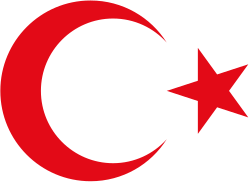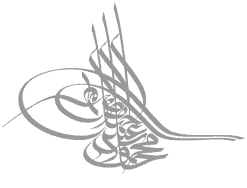Turkish art
Turkish art refers to all works of visual art originating from the geographical area of what is present day Turkey since the arrival of the Turks in the Middle Ages. Turkey also was the home of much significant art produced by earlier cultures, including the Hittites, Ancient Greeks, and Byzantines. Ottoman art is therefore to the dominant element of Turkish art before the 20th century, although the Seljuks and other earlier Turks also contributed. The 16th and 17th centuries are generally recognized as the finest period for art in the Ottoman Empire, much of it associated with the huge Imperial court. In particular the long reign of Suleiman the Magnificent from 1520–1566 brought a combination, rare in any ruling dynasty, of political and military success with strong encouragement of the arts.[1]
The nakkashane, as the palace workshops are now generally known, were evidently very important and productive, but though there is a fair amount of surviving documentation, much remains unclear about how they operated. They operated over many different media, but apparently not including pottery or textiles, with the craftsmen or artists apparently a mixture of slaves, especially Persians, captured in war (at least in the early periods), trained Turks, and foreign specialists. They were not necessarily physically located in the palace, and may have been able to undertake work for other clients as well as the sultan. Many specialities were passed from father to son.[2]
Art media
| Part of a series on the |
| Culture of Turkey |
|---|
 |
| History |
| People |
| Languages |
|
Mythology and folklore
|
| Cuisine |
| Festivals |
| Religion |
| Art |
| Literature |
|
Music and performing arts |
|
Media |
| Sport |
|
Monuments |
|
Symbols
|
|
Ottoman architecture developed traditional Islamic styles, with some technical influences from Europe, into a highly sophisticated style, with interiors richly decorated in coloured tiles, seen in palaces, mosques and turbe mausolea.[3]
Other forms of art represented developments of earlier Islamic art, especially those of Persia, but with a distinct Turkish character. As in Persia, Chinese porcelain was avidly collected by the Ottoman court, and represented another important influence, mainly on decoration.[4] Ottoman miniature and Ottoman illumination cover the figurative and non-figurative elements of the decoration of manuscripts, which tend to be treated as distinct genres, though often united in the same manuscript and page.[5]
The reign of the Ottomans in the 16th and early 17th centuries introduced the Turkish form of Islamic calligraphy. This art form reached the height of its popularity during the reign of Suleiman the Magnificent (1520–66).[6] As decorative as it was communicative, Diwani was distinguished by the complexity of the line within the letter and the close juxtaposition of the letters within the word. The hilya is an illuminated sheet with Islamic calligraphy of a description of the Prophet Muhammad. The tughra is an elaborately stylized formal signature of the sultan, which like the hilya performed some of the functions of portraits in Christian Europe. Book covers were also elaborately decorated.[7]
Other important media were in the applied or decorative arts rather than figurative work. Pottery, especially İznik pottery, jewellery, hardstone carvings, Turkish carpets, woven and embroidered silk textiles were all produced to extremely high standards, and carpets in particular were exported widely. Other Turkish art ranges from metalwork, carved woodwork and furniture with elaborate inlays to traditional Ebru or paper marbling.[8]
Later periods
In the 18th and 19th centuries Turkish art and architecture became more heavily influenced by contemporary European styles, leading to over-elaborated and fussy detail in decoration.[9] European-style painting was slow to be adopted, with Osman Hamdi Bey (1842-1910) for long a somewhat solitary figure. He was a member of the Ottoman administrative elite who trained in Paris, and painted throughout his long career as a senior administrator and curator in Turkey. Many of his works represent Orientalism from the inside, as it were.
A transition from Islamic artistic traditions under the Ottoman Empire to a more secular, Western orientation has taken place in Turkey. Modern Turkish painters are striving to find their own art forms, free from Western influence. Sculpture is less developed, and public monuments are usually heroic representations of Atatürk and events from the war of independence. Literature is considered the most advanced of contemporary Turkish arts.
Gallery
 Classical wooden Turkish houses
Classical wooden Turkish houses.jpg) İznik İsmail Bey Turkish Bath
İznik İsmail Bey Turkish Bath
_-_Google_Art_Project.jpg) sample training of Abdul Rahman Hilmi Turkish calligrapher. Ink, colours and gold on paper
sample training of Abdul Rahman Hilmi Turkish calligrapher. Ink, colours and gold on paper
See also
Notes
- Levey, 12; Rogers and Ward, throughout, especially 26-41
- Rogers and Ward, 120-124; 186-188
- Levey, throughout
- Levey, 54, 60; Rogers and Ward, 29, 186; Rawson, 183-191, and see index
- Levey, see index; Rogers and Ward, 59-119
- Rogers and Ward, 55-74
- Levey, see index; Rogers and Ward, 26-41, 62-64 on tughra
- Rogers and Ward, 120-215, cover a wide range; Levey, 51-55, and see index
- Levey, chapters 5 and 6
References
- Levey, Michael; The World of Ottoman Art, 1975, Thames & Hudson, ISBN 0500270651
- Rawson, Jessica, Chinese Ornament: The Lotus and the Dragon, 1984, British Museum Publications, ISBN 0714114316
- Rogers J.M. and Ward R.M.; Süleyman the Magnificent, 1988, British Museum Publications ISBN 0714114405
Further reading
| Wikimedia Commons has media related to Art of the Ottoman Empire. |
| Wikimedia Commons has media related to Art of Turkey. |
- Binney, Edwin. Turkish Miniature Paintings and Manuscripts, from the Collection of Edwin Binney, 3rd. New York City: Metropolitan Museum of Art; Los Angeles, Calif.: Los Angeles County Museum of Art, 1973. 139 p., amply ill. (in b&w). N.B.: Catalogue of an exhibition held at the named museums. ISBN 0-87099-077-2
- Miller, Lenore D. Echoes of Anatolia: Works of Contemporary Turkish-American Artists ... [catalogue of an] Exhibition [which] Has Been Realized through the Generosity of the Contributing Artists and [of] the Turkish Embassy in Washington, D.C. [Washington, D.C., ca. 1987]. 24 p., amply ill. (in b&w). Without ISBN